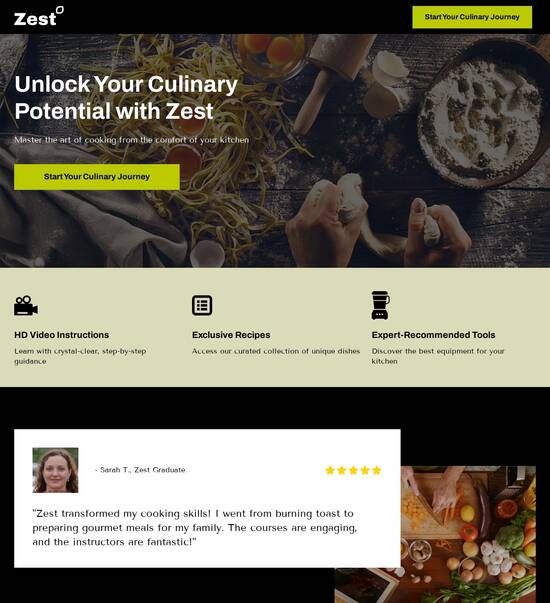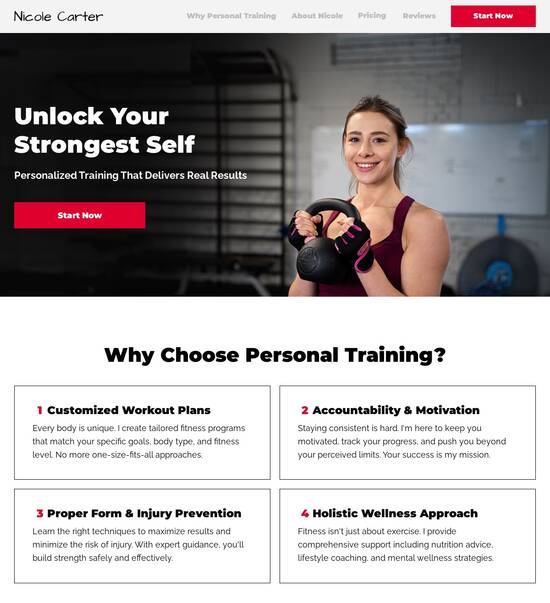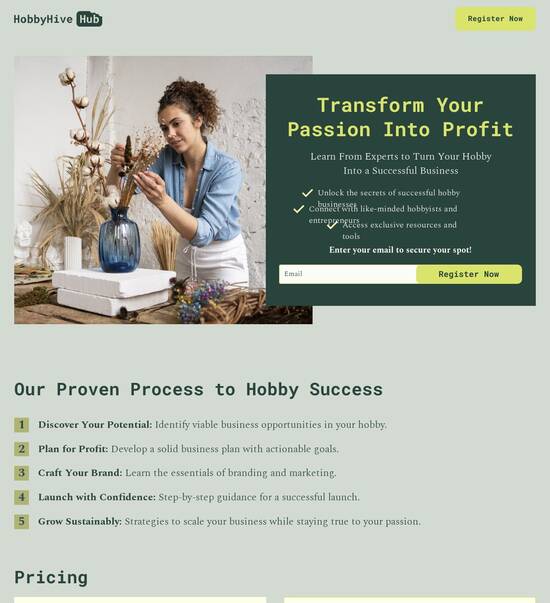
HTML page template for cookie companies
Use TemplateAbout template
Give your cookie companies a boost with our professional landing page templates. Ready to turn visitors into customers?
Recommended templates

Easy to build without coding
With the intuitive drag-and-drop builder, anyone on your team can create high-converting pages without any knowledge of code or design. Make enhancements to your landing page with custom widgets using Javascript, HTML/CSS, or third-party scripts.

Multiple layouts for any industry and goal
Select from 500+ landing page layouts built to boost conversions across industry-specific scenarios. Customize them by adjusting fonts, adding images, and generating on-brand content with the AI assistant. Quickly scale with Instablocks® and Global Blocks that you can save, reuse, and update globally.

Loads fast and looks polished on any device
Every template is responsive, which means they present professionally on any device and load blazingly fast with our Thor Render Engine. You can also power them up with Google AMP technology to deliver an unparalleled mobile experience and drive higher conversions.

Robust analytics & experimentation
Get real-time updates and reporting across all your devices, showing the number of visitors, conversions, cost-per-visitor, and cost-per-lead. Launch AI-powered experiments, run A/B tests, and use heatmaps to analyze user behavior, then optimize your landing page to maximize conversions.







Easy to build without coding
With the intuitive drag-and-drop builder, anyone on your team can create high-converting pages without any knowledge of code or design. Make enhancements to your landing page with custom widgets using Javascript, HTML/CSS, or third-party scripts.
Multiple layouts for any industry and goal
Select from 500+ landing page layouts built to boost conversions across industry-specific scenarios. Customize them by adjusting fonts, adding images, and generating on-brand content with the AI assistant. Quickly scale with Instablocks® and Global Blocks that you can save, reuse, and update globally.
Loads fast and looks polished on any device
Every template is responsive, which means they present professionally on any device and load blazingly fast with our Thor Render Engine.
Robust analytics & experimentation
Get real-time updates and reporting across all your devices, showing the number of visitors, conversions, cost-per-visitor, and cost-per-lead. Launch AI-powered experiments, run A/B tests, and use heatmaps to analyze user behavior, then optimize your landing page to maximize conversions.
All the features you need to build lead-generating landing pages
Explore more featuresLearn how to build top-performing landing pages for any goal
FAQs
Leading the way in building high-performing landing pages





A step-by-step guide to maximizing your ROI with Instapage's landing page platform
Marketers across various industries recognize the necessity of a powerful landing page tool like Instapage to enhance conversion rates. With features designed for personalization, optimization, and collaboration, you can create compelling landing pages efficiently, no matter the scale of your budget or team size. This guide will walk you through creating high-converting landing pages tailored to your target audience using Instapage.
Understanding the importance of landing pages
Landing pages serve as the gateway to your digital marketing campaigns. They play a crucial role in capturing leads and converting visitors into customers. With Instapage, you can leverage over 100 high-converting templates, ensuring a quick start for any campaign. Implementing an effective landing page strategy can significantly enhance your overall marketing efforts and ROI.
- Tailored templates: Access more than 100 professionally designed templates that can be easily customized to meet your brand's unique voice.
- Lead generation elements: Use built-in lead forms to seamlessly capture user information, crucial for follow-up marketing.
- A/B testing capabilities: Instapage allows marketers to test variations of their pages to find the highest-performing setup.
Creating your first landing page
To create an enticing landing page, follow these steps:
- Select a template: Choose a template that aligns with your campaign's goals.
- Customize your content: Modify texts, images, and CTAs to enhance relevance to your audience.
- Integrate lead capture forms: Ensure easy access for users to submit their information.
Optimizing for higher conversion rates
After launching your page, ongoing optimization is key to success. Here’s what to focus on:
- Utilize heatmaps: Understand user behavior on your page for better insights into where improvements can be made.
- Conduct A/B tests: Regularly test different layouts and content to identify variations that drive the best results.
- Monitor analytics: Use Instapage's analytics dashboard to keep track of landing page performance metrics.
To summarize, optimizing your landing pages is an ongoing task that significantly affects your marketing efforts.
Take actionable steps today using Instapage to develop high-performing landing pages that drive conversions and maximize your marketing ROI.
Discover the difference that professional landing page design can make. Start your free trial with Instapage today and transform your approach to digital marketing!
HTML page template for cookie companies
Understanding the importance of cookie compliance for cookie companies
Cookie compliance has become an essential consideration for cookie companies aiming to achieve digital transparency and trust. Cookies play a crucial role in modern websites by enabling the storage of user preferences and tracking behavioral data, which contributes to personalized user experiences. A cookie is a small piece of data that a website stores on a user’s device while they browse. These cookies allow websites to remember users and provide smoother interactions, ultimately leading to improved site performance.
The growing importance of cookies can be attributed to their ability to enhance user experiences. For example, when users revisit a site, cookies ensure that their selections, such as language preference or items in their shopping cart, remain available. Without this functionality, user experience would suffer, leading to higher bounce rates. Therefore, cookie companies should prioritize creating an HTML page template that aligns with cookie compliance and user expectations.
The legal landscape
As cookie usage has expanded, so has the legal framework governing their deployment. Regulations such as the General Data Protection Regulation (GDPR) and the California Consumer Privacy Act (CCPA) have established stringent guidelines for cookie usage, particularly concerning user consent. Cookie companies must ensure their HTML templates communicate the necessary information to users, asking for their explicit agreement before setting non-essential cookies.
Non-compliance comes with heavy repercussions, including potential fines and damage to brand reputation. It is crucial for cookie companies to recognize the significance of these regulations and incorporate compliance measures into their website design, instilling confidence in their user base.
Building trust with users
Transparency about cookie practices fosters trust between companies and their users. When users are well-informed about how their data is being collected and utilized, they are more likely to feel secure, enhancing their loyalty to the brand. Cookie companies should not only provide clear information regarding cookies but also ensure that users can easily manage their consent preferences.
Clearly communicate how cookies improve user experience.
Empower users to manage their cookie preferences easily.
Highlight the company's commitment to data privacy.
Designing an effective HTML page template for cookie companies
An effective HTML page template for cookie companies must include core elements that address user preferences and legal requirements. At its heart, a clear cookie message display informs users about cookie usage and secures their consent. This message should succinctly explain what cookies are, their purpose on the site, and the implications of opting in or out.
In addition to the core message, user-friendly design and navigation are integral for a seamless experience. The display should be easily accessible without obstructing the site’s content. Essential information related to cookie usage, such as privacy policy links and options to customize settings, must be prominently featured.
Aesthetic considerations
Aesthetically pleasing templates will engage users more effectively. Using CSS for appealing layouts can create intuitive designs that complement the site’s branding. Selecting color schemes and typography that resonate with the cookie industry—think warm colors and playful fonts—further enhances a visitor's experience. Consistency in design elements across the site is necessary to maintain a cohesive brand identity.
Crafting an impactful cookie message popup template
Cookie message popups serve a significant role in communicating essential information about cookie usage to users. They provide immediate notification about cookie practices and encourage informed consent, which is a critical requirement of many data protection regulations. A well-designed cookie message popup can significantly influence how users perceive a brand's commitment to their privacy.
Key features of an effective popup should include bold and clear messaging about cookie usage and options for users to manage their cookie preferences easily. It's important to guide users toward privacy policy links for more detailed information. Incorporating timing and frequency of popup displays can enhance user experience by avoiding nagging while ensuring that the message is received.
Enhancing user experience with optimization techniques such as attractive animations and smooth transitions can further engage users. When done correctly, these visual elements can make the cookie message less intrusive and more informative.
Developments in HTML and CSS for cookie company websites
Incorporating HTML best practices is essential for cookie companies to achieve optimal communication with their users. Utilizing semantic markup enables better accessibility, allowing information to be more readily available to all users, including those using screen readers. Additionally, using relevant meta tags can help enhance cookie-related content visibility in search engines, thereby improving overall site discoverability.
CSS techniques also play a significant role in enhancing user experience. Implementing responsive design principles ensures that cookie messages are viewable across different devices, allowing for universal accessibility. Furthermore, employing hover effects and transitions can guide user attention effectively and make interaction more intuitive.
Tailoring content to meet user preferences
Understanding user behavior and interactions is key to creating tailored cookie message experiences. Gathering user feedback on cookie message engagement is invaluable for identifying what resonates with different audiences. Analyzing site metrics, such as bounce rates and time on page, provides insights into how well your cookie messaging strategy is working, enabling continuous improvement.
Customizing the cookie message experience can also involve employing different messaging approaches based on user demographics. For instance, younger users might prefer more casual language, while older demographics may respond better to a more formal tone. Case studies of successful customization show that cookie companies that adapt their messages to different users often see increased engagement and trust.
Practical examples and successful implementations
Showcasing innovative cookie message templates can provide inspiration and guidance. Gathering a collection of real-world examples, complete with screenshots, allows cookie companies to visualize effective strategies tailored to their brand. An analysis of key features, such as clarity in messaging and user-friendly design, can help provide deeper insights into what drives positive user interactions.
Additionally, sharing success stories from cookie companies that adopted optimized cookie templates can further emphasize the argument for compliance and strategic messaging. Highlighting how these changes boosted compliance rates and improved user feedback reinforces the notion that well-executed cookie practices contribute to a positive user experience.
Solutions and tools to enhance cookie messaging
Integrating third-party solutions can significantly streamline cookie compliance processes for cookie companies. There are various tools available that simplify management, ensuring companies are always up to date with the latest legal requirements. For non-technical users, cookie management tools are particularly helpful, providing intuitive interfaces to navigate complex regulations.
In addition to these tools, leveraging user testing for continuous improvement is essential. A/B testing cookie messages to see what resonates best with users can lead to invaluable insights. Collecting user feedback through surveys or direct communication can also help businesses evolve their cookie messaging strategies effectively.
Future trends in cookie messaging templates
Anticipating user expectations and technological advancements is crucial for cookie companies. Emerging technologies that impact cookie management, such as AI and machine learning, may change how companies interact with users regarding their cookie preferences. As regulations continue to evolve, companies will need to stay vigilant to adapt and ensure compliance while providing excellent user experiences.
Personalization in user interactions will likely become even more significant. Future approaches to tailoring cookie consent messages could involve more intelligent and context-driven processes that understand user behavior and preferences. With the growing role of AI in digital marketing, companies can expect enhanced engagement and loyalty through more customized cookie messaging.
Conclusion and final thoughts
In conclusion, adopting an effective HTML page template for cookie companies is essential for achieving cookie compliance, enhancing user experience, and fostering trust. Cookie companies that take these considerations seriously will not only meet legal requirements but also create a loyal customer base. By adhering to best practices and exhibiting transparent cookie management, companies can reinforce their commitment to user privacy and experience.
Ultimately, cookie companies should prioritize user-centric designs that resonate with their audience. This proactive approach positions them favorably in a competitive digital landscape, ensuring users feel secure and engaged while interacting with the brand.
Ready to skyrocket conversions?
Supercharge your ad campaigns with high-performing landing pages
Get started














